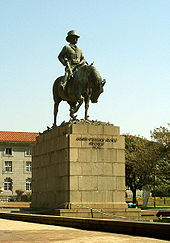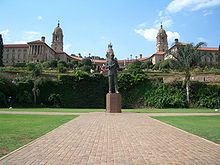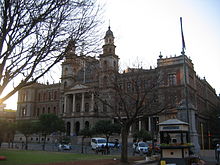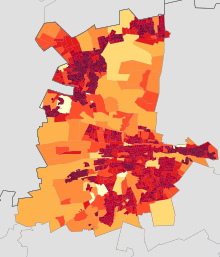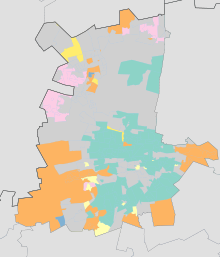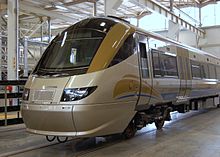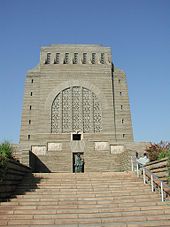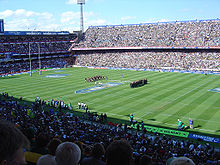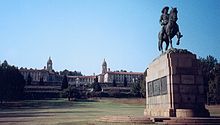
Pretoria
Background to the schools Wikipedia
SOS Children has tried to make Wikipedia content more accessible by this schools selection. Do you want to know about sponsoring? See www.sponsorachild.org.uk
| Pretoria | |||
|---|---|---|---|
| View from the Union Buildings | |||
|
|||
| Motto: Præstantia Prævaleat Prætoria (May Pretoria Be Pre-eminent In Excellence) | |||
|
|
|||
| Coordinates: 25°44′46″S 28°11′17″E Coordinates: 25°44′46″S 28°11′17″E | |||
| Country | South Africa | ||
| Province | Gauteng | ||
| Municipality | City of Tshwane | ||
| Established | 1855 | ||
| Area | |||
| • Total | 513.84 km2 (198.39 sq mi) | ||
| Elevation | 1,271 m (4,170 ft) | ||
| Population (2001) | |||
| • Total | 525,387 | ||
| • Density | 1,000/km2 (2,600/sq mi) | ||
| Racial makeup (2001) | |||
| • Black African | 24.5% | ||
| • Coloured | 6.2% | ||
| • Indian/ Asian | 1.6% | ||
| • White | 67.7% | ||
| First languages (2001) | |||
| • Afrikaans | 61.2% | ||
| • English | 15.0% | ||
| • Northern Sotho | 5.5% | ||
| • Tswana | 4.3% | ||
| • Other | 14% | ||
| Time zone | SAST ( UTC+2) | ||
| Area code(s) | 012 | ||
Pretoria is a city in the northern part of Gauteng Province, South Africa. It is one of the country's three capital cities, serving as the executive (administrative) and de facto national capital; the others are Cape Town, the legislative capital, and Bloemfontein, the judicial capital. Pretoria is sometimes regarded as being divided into three sections: West, East and north, relative to the CBD (Central Business District). Pretoria is contained within the City of Tshwane Metropolitan Municipality as one of several constituent former administrations (among which also Centurion and Soshanguve). Pretoria itself is sometimes referred to as "Tshwane" due to a long-running and controversial proposed change of name, which has yet to be decided, as of 2012.
Pretoria is named after Andries Pretorius.
Pretoria in South Africa is popularly known as The Jacaranda City due to the thousands of Jacaranda trees planted in its streets, parks and gardens.
History
The Southern Transvaal Ndebele occupied the river valley, which was to become the location of the city of Pretoria, by around 1600.
During the difaqane in Natal, another band of refugees arrived in this area under the leadership of Mzilikazi. However, they were forced to abandon their villages in their flight from a regiment of Zulu raiders in 1832.
Pretoria itself was founded in 1855 by Marthinus Pretorius, a leader of the Voortrekkers, who named it after his father Andries Pretorius. The elder Pretorius had become a national hero of the Voortrekkers after his victory over the Zulus in the Battle of Blood River. Andries Pretorius also negotiated the Sand River Convention (1852), in which Britain acknowledged the independence of the Transvaal. It became the capital of the South African Republic (ZAR) on 1 May 1860. The founding of Pretoria as the capital of the South African Republic can be seen as marking the end of the Boers' settlement movements of the Great Trek.
Boer Wars
During the First Boer War, the city was besieged by Republican forces in December 1880 and March 1881. The peace treaty which ended the war was signed in Pretoria on 3 August 1881 at the Pretoria Convention.
The Second Boer War (1899 to 1902) resulted in the end of the Transvaal Republic and start of British hegemony in South Africa. During the war, Winston Churchill was imprisoned in the Staats Model School in Pretoria but escaped to Mozambique. The city surrendered to British forces under Frederick Roberts on 5 June 1900 and the conflict was ended in Pretoria with the signing of the Peace of Vereeniging on 31 May 1902.
A number of forts were built for the defence of the city just prior to the Second Boer War. Though some of these forts are today in ruins, a number of them have been preserved as national monuments.
Union of South Africa
The Boer Republics of the ZAR and the Orange Free State were united with the Cape Colony and Natal Colony in 1910 to become the Union of South Africa. Pretoria then became the administrative capital of the whole of South Africa, with Cape Town the legislative capital. Between 1860 and 1994, the city was also the capital of the province of Transvaal, superseding Potchefstroom in that role.
On 14 October 1931, Pretoria achieved official city status. When South Africa became a republic in 1961, Pretoria remained its administrative capital.
After apartheid
After the creation of new municipal structures across South Africa in 2000, the name Tshwane was adopted for the Metropolitan Municipality that includes Pretoria and surrounding towns.
Beginning in 2005, portions of the African National Congress wished to change the name of the city to match the name of the Tshwane municipality, however this met with stiff opposition, particularly from Afrikaner civil rights groups and political parties since it denies the history of the city as founded by Pretorius.
In 1994 Peter Holmes Maluleka was elected as transitional mayor of Pretoria, until the first democratic election held later that year, making him the first black mayor of this capital of South Africa. Maluleka later became the chairman of the Greater Pretoria Metropolitan City Council (later City of Tshwane Metropolitan Municipality), then was elected Speaker of the Tshwane Metro Council and in 2004 was chosen to be a member of the South African Parliament for the Soshanguve constituency.
Geography
| Pretoria | ||||||||||||||||||||||||||||||||||||||||||||||||||||||||||||
|---|---|---|---|---|---|---|---|---|---|---|---|---|---|---|---|---|---|---|---|---|---|---|---|---|---|---|---|---|---|---|---|---|---|---|---|---|---|---|---|---|---|---|---|---|---|---|---|---|---|---|---|---|---|---|---|---|---|---|---|---|
| Climate chart ( explanation) | ||||||||||||||||||||||||||||||||||||||||||||||||||||||||||||
|
||||||||||||||||||||||||||||||||||||||||||||||||||||||||||||
|
||||||||||||||||||||||||||||||||||||||||||||||||||||||||||||
Pretoria is situated approximately 55 km (34 mi) north-northeast of Johannesburg in the north-east of South Africa, in a transitional belt between the plateau of the Highveld to the south and the lower-lying Bushveld to the north. It lies at an altitude of about 1,350 m (4,500 ft) above sea level, in a warm, sheltered, fertile valley, surrounded by the hills of the Magaliesberg range.
Climate
The city has a moderately dry subtropical climate, specifically a humid subtropical climate ( Köppen climate classification: Cwa), with long hot and rainy summers and short cool and dry winters. The average annual temperature is 18.7 °C (65.7 °F). This is rather high considering its relatively high altitude of about 1350 metres and is due mainly to its sheltered valley position, which acts as a heat trap and cuts it off from cool southerly and south-easterly air masses for much of the year. Rain is chiefly concentrated in the summer months, with drought conditions prevailing over the winter months, when frosts may be sharp. Snowfall is an extremely rare event; snowflakes were spotted in 1959, 1968 and 2012 in the city, but the city has never experienced an accumulation in its history. During a countrywide heatwave in November 2011, Pretoria experienced temperatures that reached 39 °C (102 °F), extraordinarily unusual for that time of the year. Again in December to January 2013, Pretoria experienced temperatures exceeding 37C on several days. The all-time high recorded in Pretoria was 42C on 25 January 2013
| Climate data for Pretoria | |||||||||||||
|---|---|---|---|---|---|---|---|---|---|---|---|---|---|
| Month | Jan | Feb | Mar | Apr | May | Jun | Jul | Aug | Sep | Oct | Nov | Dec | Year |
| Record high °C (°F) | 42 (108) |
37 (99) |
35 (95) |
33 (91) |
29 (84) |
25 (77) |
26 (79) |
31 (88) |
34 (93) |
36 (97) |
39 (102) |
37 (99) |
36 (97) |
| Average high °C (°F) | 29 (84) |
28 (82) |
27 (81) |
24 (75) |
22 (72) |
19 (66) |
20 (68) |
22 (72) |
26 (79) |
27 (81) |
27 (81) |
28 (82) |
25 (77) |
| Average low °C (°F) | 18 (64) |
17 (63) |
16 (61) |
12 (54) |
8 (46) |
5 (41) |
5 (41) |
8 (46) |
12 (54) |
14 (57) |
16 (61) |
17 (63) |
12 (54) |
| Record low °C (°F) | 8 (46) |
11 (52) |
6 (43) |
3 (37) |
−1 (30) |
−6 (21) |
−4 (25) |
−1 (30) |
2 (36) |
4 (39) |
7 (45) |
7 (45) |
−6 (21) |
| Precipitation mm (inches) | 154 (6.06) |
75 (2.95) |
82 (3.23) |
51 (2.01) |
13 (0.51) |
7 (0.28) |
3 (0.12) |
6 (0.24) |
22 (0.87) |
71 (2.8) |
98 (3.86) |
120 (4.72) |
703 (27.68) |
| Avg. precipitation days | 14 | 11 | 10 | 7 | 3 | 1 | 1 | 2 | 3 | 9 | 12 | 15 | 87 |
| Mean monthly sunshine hours | 261 | 235 | 254 | 246 | 283 | 271 | 289 | 296 | 284 | 275 | 254 | 272 | 3,220 |
| Source #1: South African Weather Service | |||||||||||||
| Source #2: The Weather Network (sun only) | |||||||||||||
Demographics
Depending on the extent of the area understood to constitute "Pretoria", the population ranges from 500,000 to 2.950 million. The main languages spoken in the Tshwane municipality are Pedi, Afrikaans, Tswana, Tsonga, Zulu and English. Ndebele and Sotho are also widely spoken. The whole Tshwane Metropolitan Municipality had a population of 2,985,997 at the 2011 census. The city of Pretoria has the largest white population of anywhere on the African continent. Since its founding it has been a major Afrikaner population centre, and currently there are roughly 400,000 Afrikaners living in or around the city.
Even since the end of Apartheid, Pretoria itself still has a white majority, albeit an ever increasing black middle-class. However in the townships of Soshanguve and Atteridgeville blacks make up close to all of the population. The largest white ethnic group are the Afrikaners and the largest black ethnic group are the Northern Sothos.
If one considers the lower estimate for the population of Pretoria, this includes largely former-white designated areas and there is therefore a white majority. However if one includes the geographically separate townships, this increases Pretoria's population beyond a million and makes whites a minority.
Pretoria's Indians mostly live in the Indian township of Laudium and surrounding areas, or in white suburbs.
Cityscape
Architecture
 Media related to Buildings in Pretoria at Wikimedia Commons
Media related to Buildings in Pretoria at Wikimedia Commons
Pretoria has over the years had very diverse cultural influences and this is reflected in the architectural styles that can be found in the city. It ranges from British Colonial Architecture to Art Deco with a good mix of uniquely South African style mixed in.
Some of the notable structures in Pretoria include the Union Buildings, Voortrekker Monument, the main campus of the University of South Africa, Mahlamba Ndlopfu (the President's House), Reserve Bank of South Africa (Office Tower) and the Telkom Lukas Rand Transmission Tower. Other known structures and buildings include the Loftus Versfeld Stadium, The South African State Theatre, University of Pretoria, and Head Quarters of the Department of International Relations and Co-Operation (modern architecture).
Central Business District
The Central Business District (CBD) of Pretoria has been the traditional centre of government and commerce, although today many corporate offices, small businesses, shops and government departments are situated in the sprawling suburbs of the city rather than the CBD. However to bring service delivery back to the people, various Government departments are returning to the CBD. National Departments with their Head Office in the CBD include: Department of Health, Basic Education, Transport, Higher Education and Training, Sport and Recreation, Justice and Constitutional Development, Water and Environmental Affairs and the National Treasury.
Parks and gardens
Pretoria is home to the National Zoological Gardens of South Africa as well as the Pretoria National Botanical Garden, one of the National Botanical Gardens in South Africa. There are also a number of smaller parks and gardens located throughout the city, including the Austin Roberts Bird Sanctuary..
Transport
Railway
Commuter rail services around Pretoria are operated by Metrorail. The routes, originating from the city centre, extend south to Germiston and Johannesburg, west to Atteridgeville, northwest to Ga-Rankuwa, north to Soshanguve and east to Mamelodi.
The Gautrain high-speed railway line runs from the eastern suburb of Hatfield to Pretoria Station and then southwards to Centurion, Sandton, OR Tambo International Airport and Johannesburg.
Pretoria Station is a departure point for the Blue Train luxury train. Rovos Rail, a luxury mainline train safari service operates from the colonial-style railway station at Capital Park. The South African Friends of the Rail have recently moved their vintage train trip operations from the Capital Park station to the Hercules station.
Buses
Various bus companies exist in Pretoria, of which Putco is one of the oldest and most recognised. Tshwane(Pretoria) municipality provides for the rest of the bus transport and to view the time table please visit them at Tshwane Bus Booklet.
Road
The N1 is the major freeway that runs through Pretoria. The N1 Eastern Bypass bisects the large expanse of the eastern suburbs, routing traffic from Johannesburg to Polokwane and the north of the country. The N4 Platinum Highway forms the Northern Bypass and routes traffic from Witbank to Rustenburg. The N4 runs east-west through South Africa, connecting Maputo to Gaborone. Other major freeways include the N14 which links Pretoria with Johannesburg's West Rand, and the R21 which links the city with OR Tambo International Airport.
Airports
For scheduled air services, Pretoria is served by Johannesburg's airports: OR Tambo International, 45 kilometres (28 mi) south of central Pretoria; and Lanseria, 35 kilometres (22 mi) south-west of the city. Wonderboom Airport in the suburb of Wonderboom in the north of Pretoria services light commercial and private aircraft. There are two military air bases to the south of the city, Swartkop and Waterkloof.
Society and culture
Museums
- African Window
- Freedom Park
- Kruger House (Residence of the president of the ZAR, Paul Kruger).
- Mapungubwe Museum
- Melrose House (The Treaty of Vereeniging which ended the Anglo-Boer War was signed here in 1902)
- Pretoria Forts
- Transvaal Museum
- Van Wouw Museum
- Voortrekker Monument
Music
A number of popular South African bands and musicians are originally from Pretoria. These include Desmond and the Tutus, Seether, Zebra & Giraffe, popular mostwako rapper JR, and DJ Mujava who was raised in the town of Attridgeville.
The song " Marching to Pretoria" refers to this city. The opening line of The Beatles' song I Am the Walrus, "I am he as you are he as you are me and we are all together", is based on the song "Marching to Pretoria", which contains the lyric "I'm with you and you're with me and we are all together".
Sport
One of the most popular sports in Pretoria is rugby union. Loftus Versfeld is home to the Blue Bulls, who compete in the domestic Currie Cup, and also to the Bulls in the international Super Rugby competition. The Bulls Super Rugby team, which is operated by the Blue Bulls, won the competition in 2007, 2009 and 2010. Loftus Versfeld also hosts the soccer side Mamelodi Sundowns.
Pretoria also hosted matches during the 1995 Rugby World Cup. Loftus Versfeld was used for matches of soccer in the 2010 FIFA World Cup.
There are three soccer teams in the city campaigning in South Africa's top flight football League, the Premier Soccer League. They are Mamelodi Sundowns and Supersport United. Supersport United were the 2008–09 PSL Champions. Following the 2011/2012 season the University of Pretoria F.C. will gain promotion to the South African Premier Soccer League (PSL), the top domestic league.
Cricket is also popular game in the city. As there is no international cricket stadium in the city, it does not host any major cricket tournament, although the nearby situated Centurion has Supersport Park which is an international cricket stadium and has hosted many important tournaments such as 2003 Cricket World Cup, 2007 ICC World Twenty20, 2009 IPL and 2009 ICC Champions Trophy.
Churches
- Anglican Diocese of Pretoria
- Apostolic Faith Mission of South Africa
- Central Baptist Church
- Evangelical Lutheran Church in Southern Africa
- Hatfield Christian Church
- Methodist Church of Southern Africa
- Nederduits Gereformeerde Kerk
- Roman Catholic Archdiocese of Pretoria
- Seventh-day Adventist Church
- The Church of Jesus Christ of Latter-day Saints
- Praise Tabernacle
Commerce and industry
As the national administrative (executive) capital of South Africa, Pretoria is the seat of government and houses the headquarters of the main government departments and ministries. As the de facto capital city, it also hosts the foreign embassies and diplomatic missions. The city is a major commercial centre and an important industrial centre. Its main industries are iron and steel works, copper casting, and the manufacture of automobiles, railway carriages and heavy machinery.
Pretoria has a number of industrial areas, business districts and small home businesses. A number of chambers of commerce exist for Pretoria and its business community including Pretoriaweb a business networking group that meets once a month to discuss the issues of doing business in Pretoria. The members of Pretoriaweb also discuss issues in various social media environments and on the website.
Education
Secondary education
- Afrikaanse Hoër Meisieskool
- Afrikaanse Hoër Seunskool
- Christian Brothers' College, Mount Edmund
- Clapham High School
- Crawford College Pretoria
- Deutsche Schule Pretoria
- The Glen High School
- Hillview High School
- Hoërskool Akasia
- Hoërskool C.R. Swart
- Hoërskool Centurion
- Hoërskool Die Wilgers
- Hoërskool Eldoraigne
- Hoërskool Garsfontein
- Hoërskool Gerrit Maritz
- Hoerskool Hendrik Verwoerd
- Hoërskool Hercules
- Hoërskool Langenhoven
- Hoërskool Menlopark
- Hoërskool Montana
- Hoërskool F.H. Odenaal
- Hoërskool Oos-Moot
- Hoërskool Overkruin
- Hoërskool Pretoria Noord
- Hoërskool Silverton
- Hoërskool Tuine
- Hoërskool Voortrekkerhoogte
- Hoërskool Waterkloof
- Hoërskool Wonderboom
- HTS John Vorster
- HTS Tuine
- Pretoria Boys High School
- Pretoria High School for Girls
- Pretoria Muslim School
- Pretoria Technical High School
- Pretoria West High School
- Pro Arte Alphen Park
- St. Mary's Diocesan School for Girls, Pretoria
- Willowridge High School (Pretoria)
Tertiary education
Pretoria is one of South Africa's leading academic cities and is home to both the largest residential university, largest distance education university and a research intensive university.
The Tshwane University of Technology (commonly referred to as TUT) is a higher education institution, offering vocational oriented diplomas and degrees, and came into being through a merger of Technikon Northern Gauteng, Technikon North-West and Technikon Pretoria. TUT caters for approximately 60,000 students and it has become the largest residential higher education institution in South Africa.
The University of South Africa (commonly referred to as Unisa), founded in 1873 as the University of the Cape of Good Hope, is the largest university on the African continent and attracts a third of all higher education students in South Africa. It spent most of its early history as an examining agency for Oxford and Cambridge universities and as an incubator from which most other universities in South Africa are descended. In 1946 it was given a new role as a distance education university and in 2012 it had a student headcount of over 300 000 students, including African and international students in 130 countries worldwide, making it one of the world's mega universities. Unisa is a dedicated open distance education institution and offers both vocational and academic programmes.
The University of Pretoria (commonly referred to as UP, Tuks, or Tukkies) is a multi campus public research university. The university was established in 1908 as the Pretoria campus of the Johannesburg based Transvaal University College and is the fourth South African institution in continuous operation to be awarded university status. Established in 1920, the University of Pretoria Faculty of Veterinary Science is the second oldest veterinary school in Africa and the only veterinary school in South Africa. In 1949 the university launched the first MBA programme outside of North America. Since 1997, the university has produced more research outputs every year than any other institution of higher learning in South Africa, as measured by the Department of Education's accreditation benchmark.
The Council for Scientific and Industrial Research (CSIR) is South Africa's central scientific research and development organisation. It was established by an act of parliament in 1945 and is situated on its own campus in the city. It is the largest research and development organisation in Africa and accounts for about 10% of the entire African R&D budget. It has a staff of approximately 3,000 technical and scientific researchers, often working in multi-disciplinary teams.
Change of name
On 26 May 2005 the South African Geographical Names Council (SAGNC), which is linked to the Directorate of Heritage in the Department of Arts and Culture, approved changing the name of Pretoria to Tshwane, which is already the name of the Metropolitan Municipality in which Pretoria, and a number of surrounding towns are located. Although the name change was approved by the SAGNC, it has not yet been approved by the Minister of Arts and Culture. The matter is currently under consideration while he has requested further research on the matter. Should the Minister approve the name change, the name will be published in the Government Gazette, giving the public opportunity to comment on the matter. The Minister can then refer that public response back to the SAGNC, before presenting his recommendation before parliament, who will vote on the change. Various public interest groups have warned that the name change will be challenged in court, should the minister approve the renaming. The long process involved made it unlikely the name would change anytime soon, if ever, even assuming the Minister had approved the change in early 2006.
The Tshwane Metro Council has advertised Tshwane as "Africa's leading capital city" since the name change was approved by the SAGNC in 2005. This has led to further controversy, however, as the name of the city had not yet been changed officially, and the council was, at best, acting prematurely. Following a complaint lodged with the Advertising Standards Authority (ASA), it was ruled that such advertisements are deliberately misleading and should be withdrawn from all media. Despite the rulings of the ASA, Tshwane Metro Council failed to discontinue their "City of Tshwane" advertisements. As a result, the ASA requested that Tshwane Metro pay for advertisements in which it admits that it has misled the public. Refusing to abide by the ASA's request, the Metro Council was banned consequently from placing any advertisements in the South African media that refer to Tshwane as the capital. ASA may still place additional sanctions on the Metro Council that would prevent it from placing any advertisements in the South African media, including council notices and employment vacancies.
After the ruling, the Metro Council continued to place Tshwane advertisements, but placed them on council-owned advertising boards and busstops throughout the municipal area. In August 2007, an internal memo was leaked to the media in which the Tshwane mayor sought advice from the premier of Gauteng on whether the municipality could be called the "City of Tshwane" instead of just "Tshwane". This could increase confusion about the distinction between the city of Pretoria and the municipality of Tshwane.
In early 2010 it was again rumoured that the South African government would make a decision regarding the name, however, a media briefing regarding name changes, where it may have been discussed, was cancelled shortly before taking place. Rumours of the name change provoked outrage from Afrikaner civil rights and political groups. It later emerged that the registration of the municipality as a geographic place had been published in the government gazette as it had been too late to withdraw the name from the publication, but it was announced that the name had been withdrawn, pending "further work" by officials. The following week, the registration of "Tshwane" was officially withdrawn in the Government Gazette., The retraction had reportedly been ordered at the behest of the Deputy President of South Africa Kgalema Motlanthe, acting on behalf of President Jacob Zuma, as minister of Arts and Culture Lulu Xingwana had acted contrary to the position of the ANC, which is that Pretoria, and the municipality are separate entities, which was subsequently articulated by ANC secretary general Gwede Mantashe.
In March 2010, the " Tshwane Royal House Committee", claiming to be descendents of Chief Tshwane, called for the name to be changed, and for the descendents of Chief Tshwane to be recognised, and to be made part of the administration of the municipality.
According to comments made by Mayor Kgosientso Ramokgopa in late 2011, the change will occur in 2012. However there remained considerable uncertainty about the issue.
International relations
Twin towns and sister cities
Pretoria is twinned with: Bethlehem, Palestinian Authority; Johannesburg, South Africa; Washington, D.C., United States; Taipei, Taiwan; Kiev, Ukraine; Tehran, Iran; Baku, Azerbaijan; Amman, Jordan; and Delft, Netherlands.
Shopping malls
- Atterbury Boulevard
- Atterbury Value Mart
- Brooklyn Mall*
- Brooklyn Design Square
- Centurion Mall (upon Hennops River)*
- Hatfield Plaza*
- Irene Village Mall*
- Kolonnade Centre*
- Mall @ Reds*
- Menlyn Retail Park
- Menlyn Park*
- Parkview Centre
- Sammy Marks Shopping Centre
- Sancardia Shopping Centre
- Sterland Mall*
- Sunny Park
- The Grove Shopping Centre*
- Woodlands Boulevard*
- Wonderboom Junction Shopping Centre
- Wonderpark Shopping Centre*
Note: Malls marked with an asterisk are malls with at least a 4-screen cinema complex. Kolonnade Centre was the only mall in the city with a public ice-skating rink. It closed due to high levels of rent and the management of the mall deciding to build shops in its place.
Places of interest
- Pretoria National Botanical Garden
- The National Zoological Gardens of South Africa
- Church Square
- Union Buildings
- Marabastad
- Menlyn Park
- Voortrekker Monument
- Hatfield Square
Nature reserves
- Groenkloof Nature Reserve
- Rietvlei Nature Reserve
- Moreletaspruit Nature Reserve
- Faerie Glen Nature Reserve
- Wonderboom Nature Reserve




